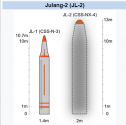The reason for persisting in the usage of older systems may not be because of the lack of technology, but because of institutional momentum. There is no lack of nuclear technology in China, with the country forging ahead with new generations of PWR and other nuclear reactor types for its power grid. It maybe because the PLAN brass is well satisfied with the current reliability and performance of the 093 and 094 power systems, knowing that it took a long road to get there. You can find examples of institutional momentum with other armed forces.
I suspect the 093/094 power plant and propulsion is not strong enough for a pump jet. While pump jet cavitates less at high RPM, it is less efficient or so they say, and its a reason why diesel electrics and AIP subs don't use that. Having mentioned that, diesel electrics are still so quiet, so a pump jet may not be a necessary feature. Still, we have no way of seeing, confirming either yes or no, that the later 093 and 094 models do or do not have a pump jet.
What I do think, is that the leap from the original 093, to the humped 093A, there is a significant leap in the quality of the sensors, and that PLAN subs are not behind when it comes to sensor or sonar technology, given the electronics and software development of their industry.
The external changes we see on the subs could be enhancing the hydrodynamics of the submarines, so not only they can be running faster or use less power for any given amount of power, but the improved hydrodynamics are reducing the flow noise around the submarines. Particular areas of flow noise around the submarine tends to be around the corners, such as the root and top corner of the sail, and the pattern, shape, and number of drainage holes. We see significant changes in those areas.
Another important area is the design of the skewed propeller itself. Being so, a photograph of the propeller should be considered OPSEC. When it comes to noise, cavitation issues and all things like that, the propeller design is vital. Development of the propeller design can be subject to so many supercomputer simulations, another area where supercomputing plays in the national defense. Its logical for China to pursue supercomputer development, but its also logical for the US to throw roadblocks on it. That's how the game goes. The design of hte propeller can vary from one sister of the same class after another, as the designs are evolved and improved. Each sister, as a result of incremental and evolutionary improvements, will have a different sound signature from each other. If you're the potential adversary, you are going to have to track each sister and record each of their unique sound signatures.
Finally there is the attitude of the submarine arm itself. The PLAN submarine arm doesn't sound as aggressive as say, back in the 2000s and 2010 period, where they would track US carrier groups, and send a nuclear sub noisily and fast around Guam or something. Instead, they seem much more restrained in recent years. Perhaps the brass has clamped down on such actions, and replaced the theater with massed surface ship operations. In contrast, the Russian Navy's submarine arm is more aggressive than ever. Not too long ago, a good number of submarines, perhaps five to seven, breached the GIUK gap. The Russians didn't display such belligerence since the Cold War. Recently you got three Russian nuclear submarines surfacing through the ice in the Arctic. I am inclined to think that changes in the PLAN admiralship since Xi Jing Ping took over, were more surface warship and carrier oriented than their predecessors that were more submarine oriented, the sub faction heavily influenced from the Soviet wing, while the surface ship faction heavily influenced by the Western wing.







